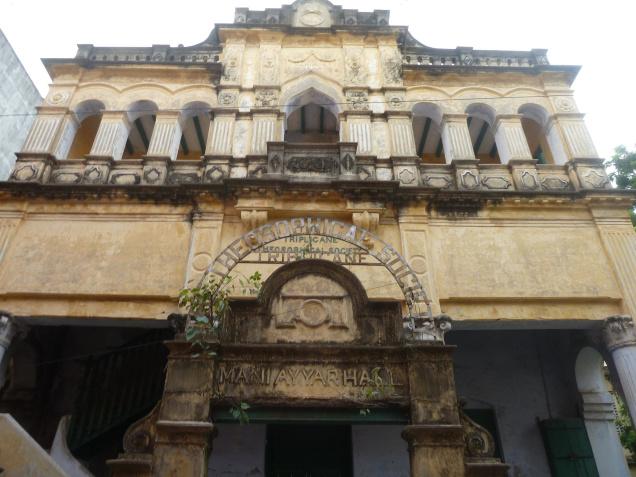
How did the once-famous Aiyer Hall in Triplicane get its name? Why is it now locked and left to crumble?
The new board outside the run-down double-storeyed building flashes the standard warning: Trespassers will be prosecuted. “You can’t go in!” shouts Thenmozhi, the flower woman nearby. “There used to be a watchman; even he is gone.” But I need answers to the multiple questions this building sparks: What is a Theosophical Society building doing in Hanumantala Street in Triplicane, far away from its headquarters in Adyar? Who built it? Why was it named Mani Ayyar/Aiyer Hall (the name is spelt in two ways on the building-front)? What went on inside? Why is it locked and left to crumble?
The long-time resident in the house opposite claims he’s been inside. “Beautifully done up in wood,” he offers. “The main hall has a lot of wood carving around. The floor is wood, as is the upper balcony. The wooden furniture inside is priceless.” Co-freemasons met here till about four years ago, he says, but “I’m afraid undesirable people may use it.”
At the Adyar library on the Theosophical Society campus, curator Jayashree finds an old booklet on the subject. The Triplicane Theosophical Lodge was founded on February 11, 1898, it says. After two decades of meeting in different places, members registered it in 1920 and decided to build a hall for its activities. The place would have a library, guest rooms, an outhouse and an “industrial school” for the poor. People like C.S. Swaminatha Mudaliar, T.B. Ramachandra Mudaliar, M.S. Venkatramana Iyer, Seshadri Iyer, Kanakasabai Pillai and P.S. Ramaswami Iyer pooled cash and with Rs. 33000, the structure was completed in 1928. The school closed down but, in 1934, additions were made on the first and second floors for meetings. “Mani Ayyar Hall is the only lodge in the Madras Theosophical Federation to own a building,” says the book and ends the chapter with, “we have 25 members, at present. Regular activities are attended by both members and non-members.”
Fine, but why Mani Aiyer? The hall was named after Dr. Sir S. Subramania Aiyer, popularly known as Mani Aiyer, venerated as the “grand old man of India,” says the book. Born on October 1, 1842, he took his law degree in 1868, enrolled as a high court vakil in 1869, made a name for himself in the Ramnad Zamindari case, improved facilities in Madura as its municipal commissioner, and became an MLC in 1884. His wife Lakshmi passed away that year and that was the beginning of a new phase in his life.
Mani Aiyer met Colonel H.S. Olcott and became an ardent theosophist, serving as vice-president of the Theosophical Society under Dr. Annie Besant.
In 1885, he was nominated to the Madras University Senate, and was its member for 22 years. In 1888, became government pleader/public prosecutor, the first Indian appointed to that post. The British government showered him with titles of CIE (1889), Diwan Bahadur (1891), and Knight Commander (1900). When Annie Besant was interned, he surrendered his knighthood in protest. His work in the fields of social reform, local self-government, political awakening of Indians, revival of Sanskrit studies and support for Indian culture made him one of the most famous men of Madras. Newspapers covered his exemplary work in and outside the court and the Gazette Extraordinary issued a statement praising him. In 1914, Annie Besant wrote: “He joined the Society in its early days and has kept unbroken his loyalty and devotion to it… [He] is a remarkable example of the ideals of youth still cherished in old age.”
The hall is one of the stops on historian V. Sriram’s walking tours of Triplicane. “The second Conference of The Music Academy was held here in April, 1930,” he said. The hall honours theosophist Sir S. Subramania Aiyer, the first Indian to become acting Chief Justice of the Madras High Court, he says. A member of the University of Madras Senate, he is commemorated with a statue — unveiled in 1935. “Mani Aiyer is remembered for his daring act of writing in 1914 to the U.S. President Woodrow Wilson that America must not assist the British in WW1, unless they commit to freeing India.
He was one of the founding members of the Indian National Congress.”
Surely, this historical building, named after an illustrious man, deserves to be restored!
source: http://www.thehindu.com / The Hindu / Home> Features> MetroPlus / by Geeta Padmanabhan / October 21st, 2014